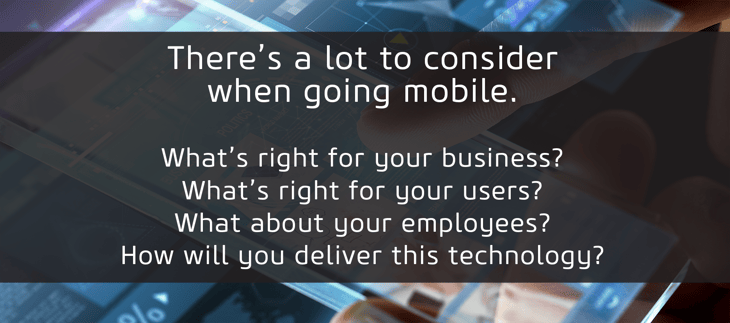There are more opportunities to reach your customers on mobile than ever before.
I read an article recently that suggested mobile apps were dead. With 87% of Canadians using a mobile device and mobile adoption rates rising globally, I’m not sure I’d agree that mobile is dead. But the catchy headline did get me thinking, and there is no question that the future of mobile and mobile apps are changing in some meaningful ways.

We see this change in some of the technical advancements in what people can do with a phone that are starting to represent the future we see in the movies – biometric authentication, augmented reality, artificial intelligence, and better connectivity are changing what’s possible.
Today, mobile devices have become integral to the way people communicate and conduct business. Our expectations of what we want to do with our phones, how we want to do it, and what that experience will be like, has a very high bar that’s getting higher.
And, business models are changing. Customer expectations, relationships, partnerships, and markets have shifted toward commoditized business models that change some of the traditional ways business is done and opens the doors to new ways of engaging with your customers and employees.
How do you take advantage of these advancements?
If you want to take advantage of these (and other) advancements, you need to step back and ask yourself some key questions to help formulate your strategy:
- What is possible for your company with a platform that extends the way you engage?
- How can you meet your customers where they are – both physically and in relation to how they are engaging with the world around them?
- How will this be different next year? In five years?
- How will this change the way you collaborate, work, and deliver great products and services?
There are 4 main ways that mobile apps can come to life, and I suspect it’s the differences between them that cause some people to claim “mobile apps are dead”:
1. Native Mobile Applications:
These apps are built specifically for mobile technology. They take can be tailored specifically to the user’s mobile tasks and experience and can take full advantage of the device’s capabilities. This also means that they need to be written, deployed, and maintained by a team that specializes in either iOS or Android.
For teams with delivery capacity, a need for in-device features, and a strong mobile value proposition, this is the smart way to go. But for many companies who are looking for a lighter mobile investment, there are options. And these options are why some are claiming the “death of [native] mobile apps”.
2. Responsive Web Apps:
These are simply mobile-friendly websites that you would access via the phone’s mobile browser. It’s the same app that you would access on a desktop browser, just scaled appropriately for mobile. The advantage to this is that you can build once and be accessible to your users wherever they are. It’s best suited to apps with occasional usage, that don’t require mobile-specific functionality and that are contextually used the same way between desktop and mobile.
The trade-off is that you forgo many of the advantages of mobile beyond camera access and reach. Your app can only be used when the phone is online (no offline access) and it doesn’t have any phone-level presence.
3. Progressive Web Apps (PWA):
These are responsive web apps, but with a device-specific front end. That means they can be accessed by the browser and through an icon on the device’s screen. This allows you to have mobile screen presence, to take advantage of device features like notifications while utilizing the same web technology as your website.
In many cases it’s easier from a delivery aspect and there are more toolkits and libraries being built to support it. The trade-off tends to be in the experience. A little more thought and care needs to be put into PWAs to ensure a smooth transition of trust for the user from the mobile app expectation to the web.
4. Hybrid Web Apps:
This is a fully functioning mobile app on the surface, with full access to device-specific features like the camera, Bluetooth, and biometric logins. Like PWAs the main business logic is stored outside of the app – in a common place where other apps (including desktop, web, and other devices) can access it. Unlike PWAs, the user will never know this because the interface looks and feels like a native mobile application.
This is a perfect solution for suites of complex tools that don’t require offline access and that the main logic isn’t predicated on device-specific features. The main trade-off is that to get something that works everywhere, you need to consider the lowest common denominator in terms of features.
So, let me reiterate: Mobile apps aren’t dead – there are just more options today and you need to have a strategy for which ones you’ll use based on your needs.

Let’s look at a few examples.
1. NATIVE MOBILE APPLICATION:
Client: Government
Users: General Public
Opportunity: This government department needed to create a seamless and secure way to provide thousands of citizens with pertinent identification data, concurrently.
Strategy: Use a rapid and truly agile approach to discovery and delivery with an MVP that could scale into some of the yet fortified ideas for the future.
Solution:
- A React native application using a secure and scalable architecture.
- Solution relies on a single source of business logic and Azure Platform Services with device-specific front-end so capacity can quickly be extended to other devices while taking advantage of unique device capabilities like offline access.
- Future phases are taking a similar agile approach to continuous delivery.
2. RESPONSIVE WEB APPLICATION:
Client: B2B SaaS Product
Users: Financial Professionals
Opportunity: The business grew from an innovative patented technology but reached its maximum potential on the current platform. They wanted a new cloud-based platform, and they wanted it fast.
Strategy: Leverage an agile approach to discovery and continual delivery to get into the market quickly and meet their pressing migration goals and attract a wider customer base. Set the product up for fast follower upgrades.
Solution:
- A responsive web application that targeted user-specific tasks.
- Works across any device with optimizations for specific user tasks on smart phones, desktops, and tablets.
- Built to extend automation and integration capabilities of partner products.
3. PROGRESSIVE WEB APPLICATION:
Client: Lottery Manufacturer
Users: Traveling Sales Reps
Opportunity: The sales reps met with clients at the store-level to review displays, catalog inventory, and provide information on new products. The analysts in the office needed to act on that same data in real-time fashion.
Strategy: A solution that would adapt to the needs of each users while providing the business with a common code base and maintenance efficiency.
Solution:
- A progressive web application that could take advantage of the newest library
features including offline access, data storage and data buffering. - Contextual and responsive interface that would adapt both the layout and the data
to be displayed based on the user permissions and the device they’re accessing the site on.

4. HYBRID MOBILE APPLICATION:
Client: B2B SaaS Product
Users: Employees of B2B Customers
Opportunity: Current platform was based on proprietary innovative technology but at its limit for our future expansion and speed to market. As they looked to the future, they wanted to use mobile to more fully support their users’ current needs and future goals.
Strategy: Complete discovery to understand business vision and the technical feasibility of creating a mobile solution to meet current go-to-market needs and enable growth with a roadmap for continual delivery of value.
Solution:
- Recommending a hybrid framework approach to take advantage of a single source of business logic while extending capacity to a mobile application.
- Development of a Proof of Concept to test and demonstrate the USP and future growth.
Whatever your goal, we can help!

Whatever ever path you choose, I can assure you the investment you’re making in mobile can go a long way in driving your business forward.
If you’re looking to get some help unpacking the world of mobile and product development – I’d love to help. From strategy, to discovery, to design or development, our Digital Studio team can get you started on the right path. Feel free to contact us today for a free consult!
 Adelle Rewerts has been at the forefront of digital transformation and mobile strategy since Blackberry was a thing. She uses her background in innovation, product design, and user experience to align business goals, user contexts, and processes. She empowers leaders to take a human-centered approach with their digital strategies.
Adelle Rewerts has been at the forefront of digital transformation and mobile strategy since Blackberry was a thing. She uses her background in innovation, product design, and user experience to align business goals, user contexts, and processes. She empowers leaders to take a human-centered approach with their digital strategies.






Submit a Comment